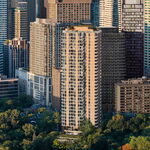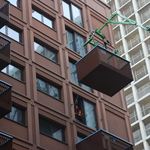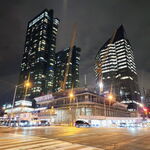cacruden
Senior Member
No
How did you do on the logic test
How did you do on the logic test
One question I'll bring up is which alignment will have the most new ridership? Anybody wanna take a stab at this one?
One question I'll bring up is which alignment will have the most new ridership? Anybody wanna take a stab at this one?
I bring this up because I get the sense looking at provincial and federal transit dollars that are unlikely to help pay for a line that does not attract any new ridership but simply makes existing ones more comfortable. That could be a problem where we want to relieve a streetcar line obviously. And that could be a problem for the whole DRL if the higher levels of government don't believe that new ridership will come from relieving Yonge/Bloor. Regardless of my preference, I think the one that'll actually sell is the alignment with the most new ridership. I'd be hard pressed to guess which alignment that would be right now.
No
How did you do on the logic test
Very well I'd say...
The question the poll is asking is "What is your prefere alignment for a new E/W subway through Downtown" <- taken verbatim
A person's preference would in part be chosen by taking ridership levels into account I would think.
I don't think that follows, no.
If we built a Queen Street Subway to replace the Queen Streetcar, we'd just be giving existing riders a more comfortable ride, hence, not much improved ridership levels. Yes it'll encourage growth, but not so much as a totally different alignment serving an underserved corridor such as the DRL.
It may indirectly attract new riders by taking existing riders from other routes, freeing capacity.
Perhaps true, but the objective of the relief line isn't to improve ridership levels. It's to relieve the Yonge line, as ridership there can't increase otherwise.If we built a Queen Street Subway to replace the Queen Streetcar, we'd just be giving existing riders a more comfortable ride, hence, not much improved ridership levels. Yes it'll encourage growth, but not so much as a totally different alignment serving an underserved corridor such as the DRL.
Regardless of alignment that would still have to be quantified I would think. ie. system wide ridership increase.
I think this is important because it played a part in the political freakshow that became Ottawa's light rail cancellation. The new mayor argued that the new LRT would not attract enough new riders while saddling the city with the extra cost of enhanced rail operations (over and above the O-train). The feds agreed and withheld funding till Ottawa agreed to come up with a better plan. I foresee the same situation for the DRL. If the TTC can't show that there will be a significant boost to net ridership than there is no way the feds are going to be pitching in and there might not even be provincial buy-in (Queen's Park backed the feds in Ottawa).
Yet you don't like the idea of it hitting 4 stations through the Richmond-Adelaide alignment.The only reason I'd prefer wellington is because of the that option to build pathways to three subway stations.
1. I've lost count of how many times I've told you that I don't support a subway on Queen (not physically practical), I support Richmond/Adelaide... there's a difference, please recognize it's a difference and stop misrepresenting my position.As for Railization's points, while I agree that he/she makes a good case for a subway on Queen (and I don't dispute the need for some improvement on Queen), I simply disagree that a Queen line should be shoehorned into a DRL. ......What's the point of building a relief line if it provides no relief to Yonge/Bloor? Neither you nor Railization has yet demonstrated how moving the line that far north will relieve Yonge/Bloor. Instead, yours and his/her case is based on the busyness of the Queen and King streetcars and Railization's assertion that Union needs relief. I don't buy that a line specifically meant to relieve Yonge/Bloor should now have priorities refocused to important but lesser priority issues.
Yet this has been the focus of your argument, since, according to you, all existing ridership on Yonge at College, Dundas, and Queen, are all unrelated to Bloor-Yonge's high activity and so would provide no relief.As for debates on development and such....to me it's just bonus if a DRL serves new development
You've got to be kidding.what about the Ex, Skydome, CN Tower, ACC, St. Lawrence market, Fort York, Roy Thompson Hall, the Hockey Hall of Fame, Sony Centre,
This isn't how ridership patterns work. Part of the point is that people want to avoid Bloor-Yonge and would be willing to transfer to the reverse-peak direction for some stations like Dundas or College. And R/A alignment provides direct access to both King and Queen at Yonge, so no transfer to either of those would happen anyway.So all commuters travelling east of Pape to King and points south would use the DRL while all the rest would travel via Yonge/Bloor. Shift the subway north to Queen and folks going to King and Union actually need to get off and change at Queen. They won't. They'll ride to Yonge/Bloor defeating the whole purpose of this multi-billion dollar investment.
You don't "only help out half" with R/A, you hit both equally, and that's the point of it. R/A would be well-used by anybody travelling between Front St. (or Esplanade) and Shuter (or Dundas).But don't forget that many of those folks also work north of Queen and south of king. In building the DRL to relieve Y/B you'd have to end up prioritizing one of those sets....either you end up running it along Queen or King or you end up with that hybrid Richmond/Adelaide deal where you only help out half the commuters with their preferred alignment (presuming we are splitting the tracks here).
King St. alone if you only target one corridor, yes, but why target only one when you can target two well-used corridors? The ridership base is there, I posted the projection several pages ago, and we should follow the logical and tried-tested-and-true method of progressively upgrading technologies as required, and not gamble with new developments, especially transit-first designed developments that will offer great transit service without a subway (and designed to work without a subway) - if it ain't broke, don't fix it.Looking strictly at the ridership numbers though I would submit that King or further south is the best alignment is probably best:
King + St. Andrew is approximately 112k riders.
Osgoode + Queen is approximately 77k riders.
Union is approximately 81k riders.
So King's probably the best by the numbers.
You can't say there are no CIPs that relate to Queen when Queen is a boundary. You can't just ignore information you find inconvenient. Furthermore, in the east, Front and King are so close together that Richmond/Adelaide becomes the mid-point of the zone, and would thereby be serving these zones best with such an alignment. You ignore this, just like you ignore the LRT networks for the Portlands and surrounding areas, passing it off as "a dog's breakfast" without proof.If we are talking about the future, most of the CIPs Railization put up still put Queen at the northern edge while King runs right through those neighbourhoods, with Front as the southern edge…and of course some of the CIPs are entirely south of Front (Portlands). That's why I didn't buy that there was a CIP for Queen….it's simply the boundary for most of the plans with most development scheduled to take place south of it.
Some inside scoop for you: Metrolinx's DRL was supposed to be in the 15 year plan if Metrolinx staff had their way, but TTC and City Hall people insisted that it be pushed off so that "it doesn't suck away funds from Transit City." It's not Metrolinx staff's fault, and has little to do with priorities based on real needs, it's all about politics.Indeed if the TTC was that worried about Queen today, don't you think we'd have a Queen subway higher up on the list instead of falling in the 25 year plan with the hope of it being grafted on to a DRL?
It goes beyond that. There's a long list of pre-conditions that Metrolinx hasn't budgeted for, but being demanded by the City. The DRL's eastern leg is a cheaper alternative to these pre-conditions.The only reason the DRL might get bumped up is to getting better use out of the half billion or so that we might have to spend relieving Yonge/Bloor.
Well-said.I disagree with using Union Station's high ridership numbers to justify a connection with the DRL. I travel south on Yonge during the morning rush, often to Union. Based purely on observation, King and Dundas are tied for having the greatest number of people getting off the southbound trains. For third place, I would say that Queen has a slight edge, and Union is fourth. Union easily has the most boardings, but by default, these trips are all in the reverse peak direction.
Union Station's high ridership can be attributed to the reverse direction commuting of GO passengers. As such, connecting the DRL to Union would provide a relatively small benefit to existing TTC customers, and even less a benefit to those who actually do board at Union (GO riders) because their destinations are not accessible by DRL.
Even if one disregards the presence of the 501 streetcar, a Queen alignment still offers the greatest potential to offer existing TTC riders a chance to walk to their destination rather than transfer back onto the YUS.
Why can't it do all 3 (include the more important King car, too, and make it do all 4) when it is perfectly practical to design it so?As keithz points out, it's to relieve Bloor-Yonge, NOT to relieve the Queen streetcar, NOT to relieve Union station.
GO Transit is going to keep Union extremely busy within 10 years from now and doesn't need a DRL to increase activity there. The DRL is actually the last thing Union needs.Union is still not the busiest that it could be. So it can handle more traffic.
GO Transit is going to keep Union extremely busy within 10 years from now and doesn't need a DRL to increase activity there. The DRL is actually the last thing Union needs.
Is that test applied to the Yonge or York U extensions, especially net new riders including GO Transit, etc.?
I don't think that follows, no.
If we built a Queen Street Subway to replace the Queen Streetcar, we'd just be giving existing riders a more comfortable ride, hence, not much improved ridership levels. Yes it'll encourage growth, but not so much as a totally different alignment serving an underserved corridor such as the DRL.




